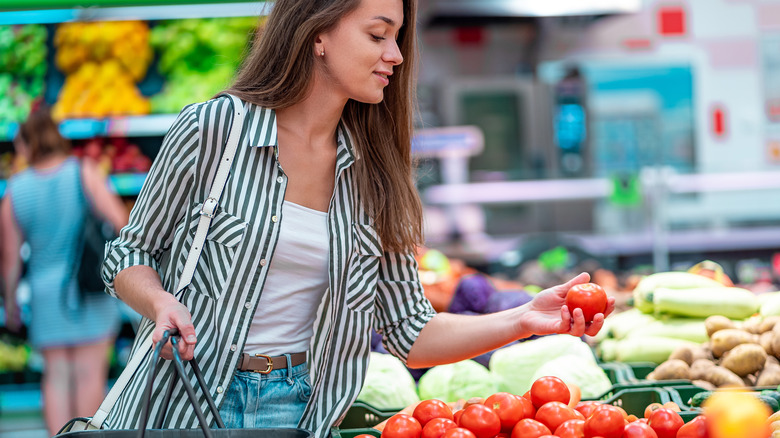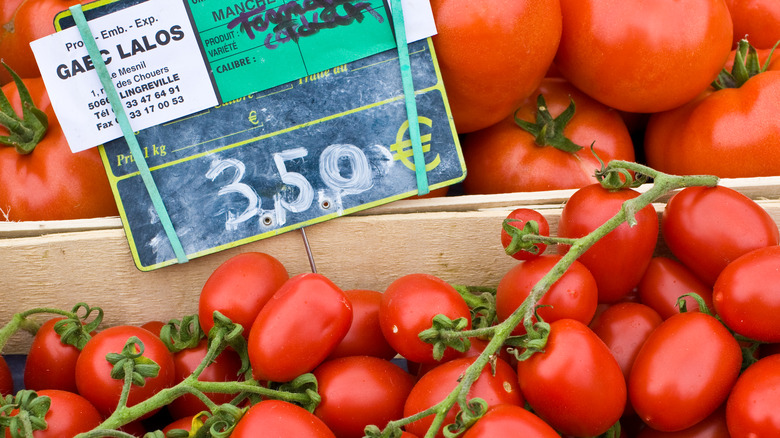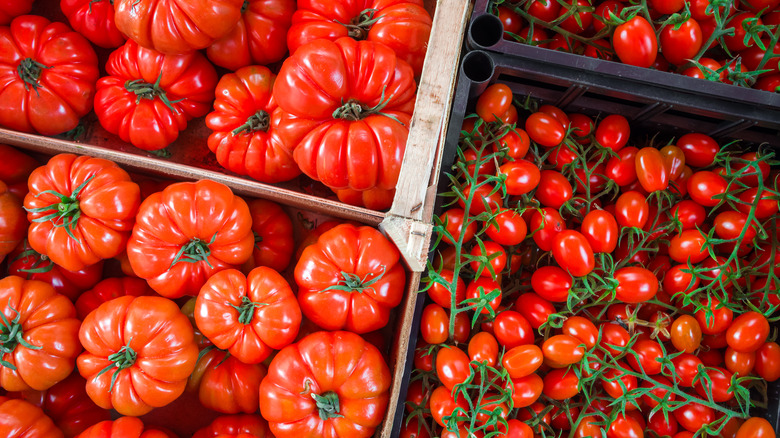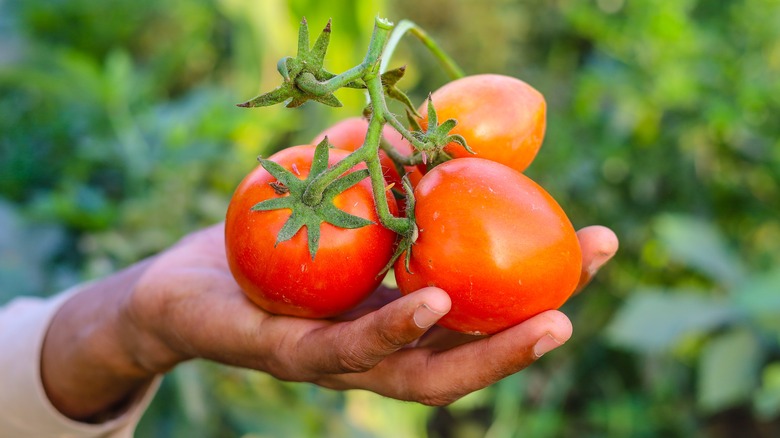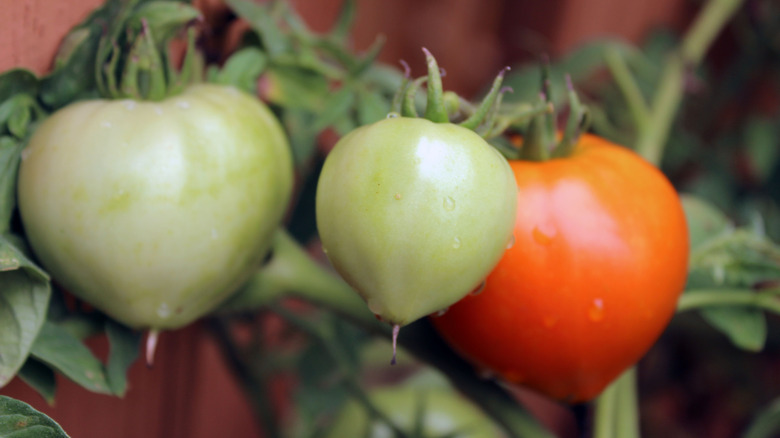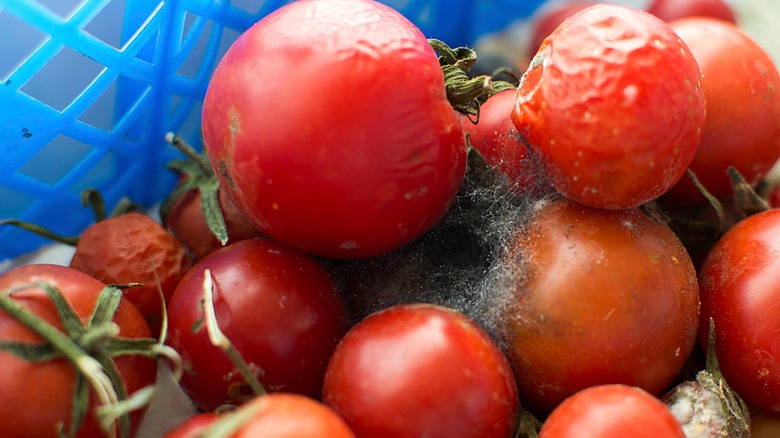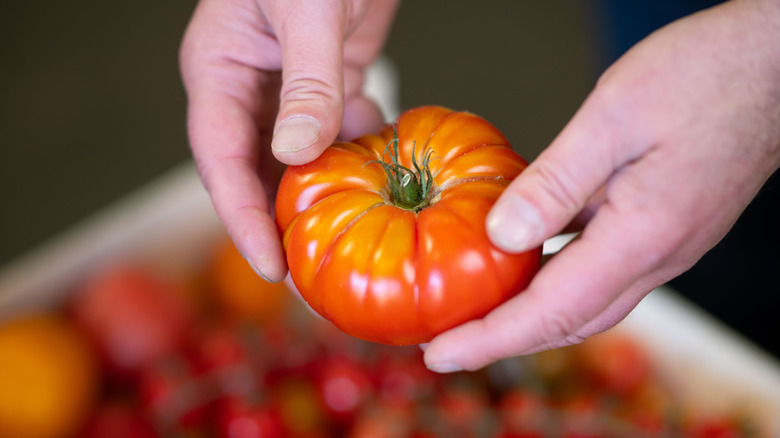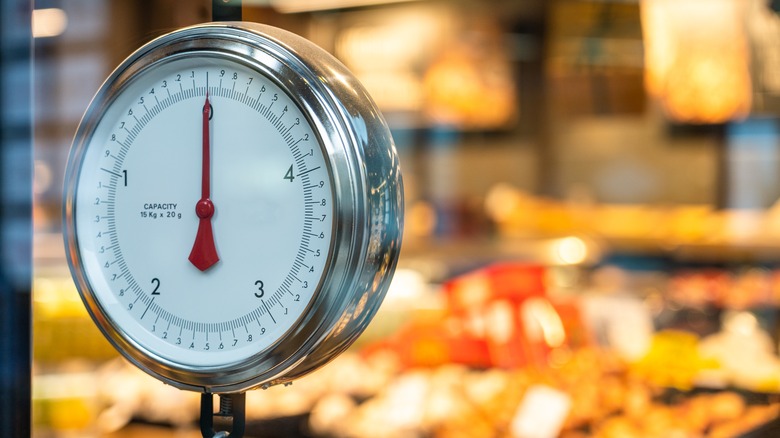Tips You Need To Follow When Buying Tomatoes At The Grocery Store
According to BBC News, tomatoes are the world's most popular fruit. That's partly because there are so many ways you can use tomatoes, aside from enjoying them in their purest form. This fruit can be transformed into chili, spaghetti sauce, jam, and paste, or simply sliced and added to a burger or sandwich.
Tomatoes are available in many different sizes and varieties. As noted by the University of Illinois Urbana-Champaign, smaller types, like grape and cherry tomatoes, are grown in several shades of red and orange. Their small sizes lend well to salads and snacks. In contrast, larger varieties, such as Big Boy and beefsteak tomatoes, are ideal for slicing. They're also great in dips and sauces because they're so juicy.
Regardless of which type is your favorite, you should know how to pick out the best tomatoes at the grocery store. We've put together a few tips that will help you find the ripest and highest-quality tomatoes that will taste great and last until you're ready to use them.
On the vine or off the vine?
The first thing you might notice when shopping for tomatoes is that they are available both on and off the vine. A video from the Cooperative Extension at Highmoor Farm of the University of Maine explains that some tomatoes are bush plants, while others are vine plants. Bush plants remain low to the ground and don't usually need support to grow. However, vine tomato plants grow larger and benefit from support from stakes.
So, is one really better than the other? According to Paul Adams from America's Test Kitchen (via Cook's Illustrated), on-the-vine tomatoes might seem more compelling, but they're not necessarily better, nor are they worth their boosted price. Adams explains that tomatoes grown commercially are harvested when they're still green. Some tomatoes get treated with ethylene gas, a natural compound released by fruits and veggies (via the University of Maine) that ripens them while being transported and stored. Others get harvested with their vines attached, which usually allows them to ripen without the need for added ethylene gas. Adams adds that the taste of each is virtually indistinguishable from one another. Therefore, if budget-friendliness is your priority, you can probably save some money by choosing off-the-vine tomatoes.
Look for locals
If you live near produce farms, there's a good chance your town's grocery stores stock locally grown fruits and vegetables. And, there are several good reasons you'll want to buy local tomatoes rather than those shipped nationwide. According to Rodale Institute, small-scale farmers tend to use more sustainable practices than mass-produced agricultural businesses. You might find local tomatoes more flavorful, too, because they're often harvested more recently than those shipped from longer distances, per Michigan State University. As soon as fruits are picked, they begin losing vitamins and minerals. Locally sourced foods require shorter travel periods and, thus, retain more nutrients, as well (via Rodale Institute).
Look for markers on bins or sections in the produce area of the grocery store that indicate the tomatoes are grown at local sources. You can also ask a store supervisor what farms it partners with and what produce items it typically carries. If your grocery stores don't have local partners, you can find nearby farmers' markets, community-supported agriculture (CSA) programs, and food hubs through the USDA's local food directories.
Stock up when they're in season
Seasonal produce is harvested and bought close to its harvesting time (via Seasonal Food Guide). Tomatoes are usually in season during the summer, with their prime season lasting from May through October, depending on the variety (per Diabetes Food Hub). Fruits that are bought in season tend to have a better taste, higher quality, and increased nutritional value (via AFPA).
Unfortunately, the tomatoes you buy during their peak growing season won't last until the next one. You can buy imported and greenhouse-grown tomatoes any time of year. You can also extend your in-season tomatoes by buying them in bulk and freezing them. The UNL Food Institute of Agriculture and Natural Resources states that you can freeze whole tomatoes by cleaning them with cold water, drying them thoroughly, and cutting and removing the stem scar. Then, place the tomatoes in a single layer on a cookie sheet to freeze. Once frozen, seal them in airtight containers or bags until you're ready to use them.
Consider their coloring
We tend to think of tomatoes as bright red in color. Although many are, they can also be various shades of orange and yellow. Regardless of what color of the rainbow they are, you can still pick out the best tomatoes based on their coloring.
According to the University of California Agriculture and Natural Resources, one of the most important things to look at is the brightness of the tomato's skin. Dull, faded coloring is a sign that the fruit isn't fully ripened. Although tomatoes can still ripen a bit more after you take them home, you'll want them to be as close to ripe as possible — especially if you plan to eat them soon. Tomatoes that are very dark in color may be over-ripened, so be careful buying them if you don't plan to use them in the next day or two.
The Missouri Botanical Garden adds that patchy coloring, like blotches of yellow or orange on an otherwise red tomato, is a sign of uneven ripening. This can be caused by infestation, disease, or poor soil or weather conditions. Whatever the cause, uneven ripening could lead to poor taste, texture, and quality.
Examine them for blemishes
There's a lot that tomatoes can tell you just by how their exteriors look, so your eyes come in handy again here. The Missouri Botanical Garden lists several potential blemishes you might find on tomatoes that could be signs of problems. One of the easiest to spot is holes in your tomatoes, which are usually caused by a tomato fruitworm infestation. The fruitworms typically create a tunnel from one side of the tomato to the other side. You might also see zippering or lines running along the sides of the tomato, almost like a scar. This happens when tomato flowers entangle the fruit, sometimes ripping part of the tomato open.
Other blemishes are not as noticeable at first glance, such as rotting. Small spots can start to rot, like the bottom of a tomato that was sitting on the ground for a while. Before buying a tomato, rotate it to examine all sides for black spots, soft spots, holes, and scars.
Put them through a touch and sniff test
When it comes to finding the ideal tomatoes to buy, you should take full advantage of your senses. We've already mentioned looking at the color, but you can also use your nose and hands to determine what tomatoes will give you the best bang for your buck.
First, look for tomatoes that are mostly firm with a slight amount of give. According to the University of California Agriculture and Natural Resources, tomatoes should feel firm when you hold them but push in a little when you squeeze gently with your fingertips. You can also carefully slide your thumb along the outside from end to end. If the skin wrinkles, it could be a sign of over-ripening. The Center for Food Safety also suggests choosing tomatoes that lean on the heavier side compared to their size.
Next, use your nose. If you've smelled ripened tomatoes before, you're probably aware of their grassy smell. This smell comes from the stem and leaves, which emit compounds that give off an earthy scent (via ScienceDaily). Although this smell is off-putting to some, the Center for Food Safety explains that it's a good sign that your tomatoes are fresh.
Pay attention to pricing
The look and feel of the tomatoes you're buying are important, but so is the price of tomatoes, especially if you're shopping on a budget. Some tomatoes cost quite a bit more, depending on their variety and scarcity. And, since tomato prices have been steadily rising, on average, since the 1980s (via FRED Economic Data), it's a good idea to make sure you're getting the most for your money.
One of the best ways to do that is to pay attention to the per-pound price of tomatoes, which is typically how grocery stores price them. One variety could cost several cents less per pound than another. A good way to understand the difference in potential costs is to weigh tomatoes in the store. According to NIST, inspectors routinely check the accuracy of the produce scales in stores, so you should feel good about using them to get an idea of pricing.
Compare two or three tomato varieties by weighing them and calculating their costs based on their weights and per-pound pricing. Say, for example, that one variety of tomatoes costs $0.89 per pound. Three pounds would cost just $2.67. However, another variety costs $1.39 per pound, so just 2 pounds of them would cost more than 3 pounds of the first tomato variety. Therefore, if the tomatoes are comparable in looks and quality, you'll get more for your money with the cheaper tomatoes.
